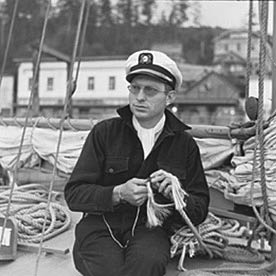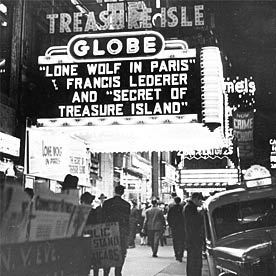Orders Is Orders (11 page)

White Russian:
a Russian who fought against the Bolsheviks (Russian Communist Party) in the Russian
Revolution, and fought against the Red Army during the Russian Civil War from 1918
to 1921.
whitewash:
a white liquid that is a mixture of lime or powdered chalk and water, used for making
walls or ceilings white.
L. Ron Hubbard in the
Golden Age of
Pulp Fiction
I
n writing an adventure story
a writer has to know that he is adventuring
for a lot of people who cannot.
The writer has to take them here and there
about the globe and show them
excitement and love and realism.
As long as that writer is living the part of an
adventurer when he is hammering
the keys, he is succeeding with his story.
Adventuring is a state of mind.
If you adventure through life, you have a
good chance to be a success on paper.
Adventure doesn’t mean globe-trotting,
exactly, and it doesn’t mean great deeds.
Adventuring is like art.
You have to live it to make it real.
— L. Ron Hubbard
L. Ron Hubbard
and American
Pulp Fiction
B
ORN
March 13, 1911, L. Ron Hubbard lived a life at least as expansive as the stories
with which he enthralled a hundred million readers through a fifty-year career.
Originally hailing from Tilden, Nebraska, he spent his formative years in a classically
rugged Montana, replete with the cowpunchers, lawmen and desperadoes who would later
people his Wild West adventures. And lest anyone imagine those adventures were drawn
from vicarious experience, he was not only breaking broncs at a tender age, he was
also among the few whites ever admitted into Blackfoot society as a bona fide blood
brother. While if only to round out an otherwise rough and tumble youth, his mother
was that rarity of her time—a thoroughly educated woman—who introduced her son to
the classics of Occidental literature even before his seventh birthday.
But as any dedicated L. Ron Hubbard reader will attest, his world extended far beyond
Montana. In point of fact, and as the son of a United States naval officer, by the
age of eighteen he had traveled over a quarter of a million miles. Included therein
were three Pacific crossings to a then still mysterious Asia, where he ran with the
likes of Her British Majesty’s agent-in-place for North China, and the last in the
line of Royal Magicians from the court of Kublai Khan. For the record, L. Ron Hubbard
was also among the first Westerners to gain admittance to forbidden Tibetan monasteries
below Manchuria, and his photographs of China’s Great Wall long graced American geography
texts.
Upon his return to the United States and a hasty completion of his interrupted high
school education, the young Ron Hubbard entered George Washington University. There,
as fans of his aerial adventures may have heard, he earned his wings as a pioneering
barnstormer at the dawn of American aviation. He also earned a place in free-flight
record books for the longest sustained flight above Chicago. Moreover, as a roving
reporter for
Sportsman Pilot
(featuring his first professionally penned articles), he further helped inspire a
generation of pilots who would take America to world airpower.

L. Ron Hubbard, left, at Congressional Airport, Washington, DC, 1931, with members
of George Washington University flying club.
Immediately beyond his sophomore year, Ron embarked on the first of his famed ethnological
expeditions, initially to then untrammeled Caribbean shores (descriptions of which
would later fill a whole series of West Indies mystery-thrillers). That the Puerto
Rican interior would also figure into the future of Ron Hubbard stories was likewise
no accident. For in addition to cultural studies of the island, a 1932–33 LRH expedition
is rightly remembered as conducting the first complete mineralogical survey of a Puerto
Rico under United States jurisdiction.
There was many another adventure along this vein: As a lifetime member of the famed
Explorers Club, L. Ron Hubbard charted North Pacific waters with the first shipboard
radio direction finder, and so pioneered a long-range navigation system universally
employed until the late twentieth century. While not to put too fine an edge on it,
he also held a rare Master Mariner’s license to pilot any vessel, of any tonnage in
any ocean.

Capt. L. Ron Hubbard in Ketchikan, Alaska, 1940, on his Alaskan Radio Experimental
Expedition, the first of three voyages conducted under the Explorers Club Flag.
Yet lest we stray too far afield, there is an LRH note at this juncture in his saga,
and it reads in part:
“I started out writing for the pulps, writing the best I knew, writing for every mag
on the stands, slanting as well as I could.”
To which one might add: His earliest submissions date from the summer of 1934, and
included tales drawn from true-to-life Asian adventures, with characters roughly modeled
on British/American intelligence operatives he had known in Shanghai. His early Westerns
were similarly peppered with details drawn from personal experience. Although therein
lay a first hard lesson from the often cruel world of the pulps. His first Westerns
were soundly rejected as lacking the authenticity of a Max Brand yarn (a particularly
frustrating comment given L. Ron Hubbard’s Westerns came straight from his Montana
homeland, while Max Brand was a mediocre New York poet named Frederick Schiller Faust,
who turned out implausible six-shooter tales from the terrace of an Italian villa).
Nevertheless, and needless to say, L. Ron Hubbard persevered and soon earned a reputation
as among the most publishable names in pulp fiction, with a ninety percent placement
rate of first-draft manuscripts. He was also among the most prolific, averaging between
seventy and a hundred thousand words a month. Hence the rumors that L. Ron Hubbard
had redesigned a typewriter for faster keyboard action and pounded out manuscripts
on a continuous roll of butcher paper to save the precious seconds it took to insert
a single sheet of paper into manual typewriters of the day.

L. Ron Hubbard, circa 1930, at the outset of a literary career that would finally
span half a century.
That all L. Ron Hubbard stories did not run beneath said byline is yet another aspect
of pulp fiction lore. That is, as publishers periodically rejected manuscripts from
top-drawer authors if only to avoid paying top dollar, L. Ron Hubbard and company
just as frequently replied with submissions under various pseudonyms. In Ron’s case,
the list included: Rene Lafayette, Captain Charles Gordon, Lt. Scott Morgan and the
notorious Kurt von Rachen—supposedly on the lam for a murder rap, while hammering
out two-fisted prose in Argentina. The point: While L. Ron Hubbard as Ken Martin spun
stories of Southeast Asian intrigue, LRH as Barry Randolph authored tales of romance
on the Western range—which, stretching between a dozen genres is how he came to stand
among the two hundred elite authors providing close to a million tales through the
glory days of American Pulp Fiction.

A Man of Many Names
Between 1934 and 1950, L. Ron Hubbard authored more than fifteen million words of
fiction in more than two hundred classic publications.
To supply his fans and editors with stories across an array of genres and pulp titles,
he adopted fifteen pseudonyms in addition to his already renowned L. Ron Hubbard byline.
______
Winchester Remington Colt
Lt. Jonathan Daly
Capt. Charles Gordon
Capt. L. Ron Hubbard
Bernard Hubbel
Michael Keith
Rene Lafayette
Legionnaire 148
Legionnaire 14830
Ken Martin
Scott Morgan
Lt. Scott Morgan
Kurt von Rachen
Barry Randolph
Capt. Humbert Reynolds

In evidence of exactly that, by 1936 L. Ron Hubbard was literally leading pulp fiction’s
elite as president of New York’s American Fiction Guild. Members included a veritable
pulp hall of fame: Lester “Doc Savage” Dent, Walter “The Shadow” Gibson, and the legendary
Dashiell Hammett—to cite but a few.
Also in evidence of just where L. Ron Hubbard stood within his first two years on
the American pulp circuit: By the spring of 1937, he was ensconced in Hollywood, adopting
a Caribbean thriller for Columbia Pictures, remembered today as
The Secret of Treasure Island.
Comprising fifteen thirty-minute episodes, the L. Ron Hubbard screenplay led to the
most profitable matinée serial in Hollywood history. In accord with Hollywood culture,
he was thereafter continually called upon to rewrite/doctor scripts—most famously
for long-time friend and fellow adventurer Clark Gable.

The 1937
Secret of Treasure Island,
a fifteen-episode serial adapted for the screen by L. Ron Hubbard from his novel,
Murder at Pirate Castle
.
In the interim—and herein lies another distinctive chapter of the L. Ron Hubbard story—he
continually worked to open Pulp Kingdom gates to up-and-coming authors. Or, for that
matter, anyone who wished to write. It was a fairly unconventional stance, as markets
were already thin and competition razor sharp. But the fact remains, it was an L.
Ron Hubbard hallmark that he vehemently lobbied on behalf of young authors—regularly
supplying instructional articles to trade journals, guest-lecturing to short story
classes at George Washington University and Harvard, and even founding his own creative
writing competition. It was established in 1940, dubbed the Golden Pen, and guaranteed
winners both New York representation and publication in
Argosy.